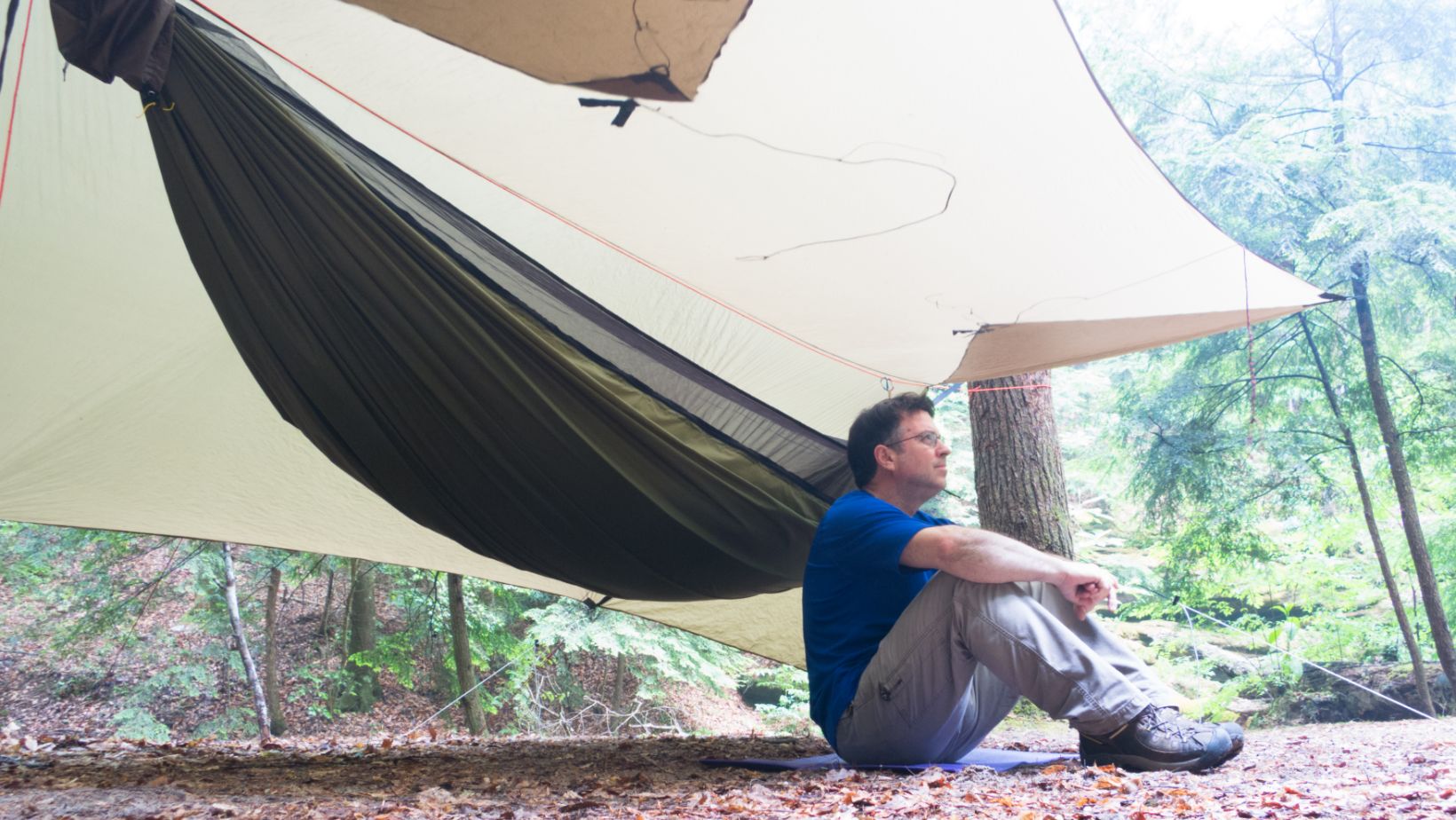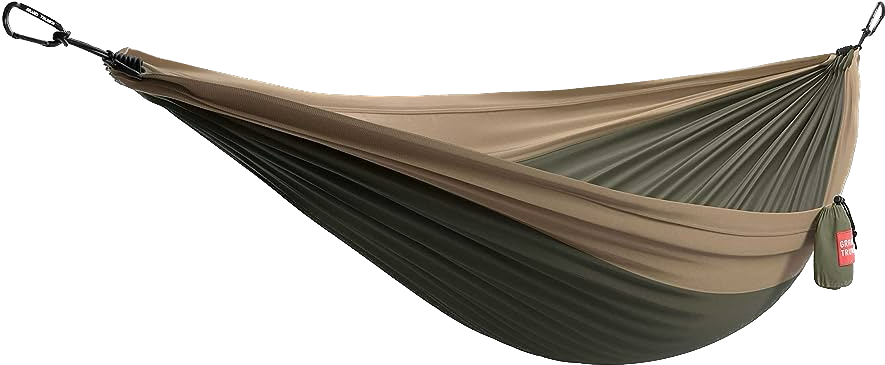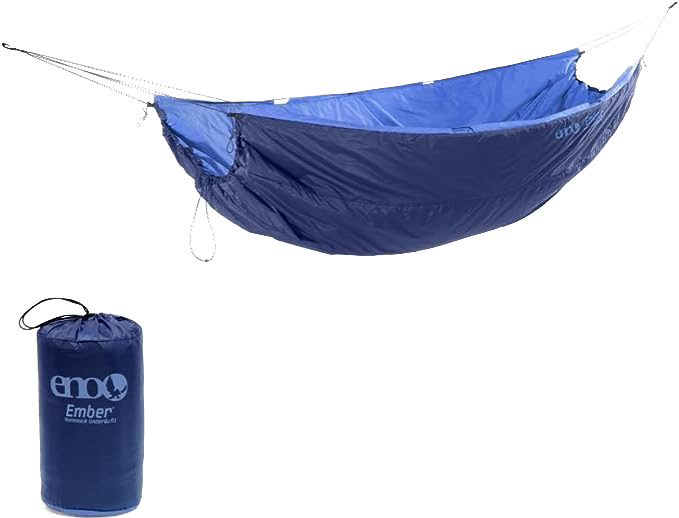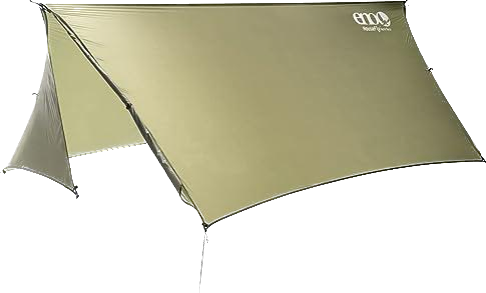Hammock camping in hot weather can present its own set of unique challenges – namely, how to stay cool. This is true especially if you’re exposed directly in the sunlight. With hammock camping season typically happening in the summer months, figuring out how to escape the heat and soaring temperatures is critical.
This guide will walk through tips and tricks on staying cool and comfortable in a hammock, even when temperatures are high. Whether it’s setting up your hammock in a shady breezy area or getting a cooling pad, learn some handy tricks here for when you’re hammocking in hot weather!
Short Summary
- Hammock camping offers superior airflow for a cool and comfortable experience.
- Shade selection, breathable fabrics, moisture-wicking properties & essential accessories can help maximize comfort in hot weather.
- Stay hydrated and protected from UV rays with the right preparation & clothing choices!
1. Set your Hammock Camp to Receive Natural Airflow

Natural air flow is one of many wonderful advantages brought about by hammocking. By sleeping suspended in hammocks, outdoor enthusiasts can stay cool from the circulating air and gentle breezes that come in. This is probably the biggest advantage a hammock has over a tent camping where tents will trap in the heat – especially in warm weather.
You can optimize the amount of airflow your hammock will receive by trying the following:
- Set your hammock up in a shaded but open area
- Position your hammock perpendicular to the breeze
- Hang your rainfly and bug net higher than usual so as to not trap heat or keep out the breeze
- Pack hammocks with breathable materials
- Hang your suspension straps or whoopie slings slightly looser than normal – a slight sag will all the sides of the hammock to spread out and improve airflow
While not the end all be all, getting your hammock properly set for natural airflow could help keep you cool throughout your hammocking trip.
2. Hang Your Hammocks in the Shade
When hammock camping in hot weather, seeking shade becomes a top priority to escape the scorching sun and high temperatures. Hanging your hammock in a shaded area not only provides relief from direct sunlight but also maintains a cooler and more pleasant environment for lounging or sleeping. Follow these tips when seeking out shade:
- Look for shady spots under tree canopies or natural barriers from direct sunlight
- Plan hammock hanging during cooler parts of the day to avoid peak sun hours
- Position the hammock to stay in the shade as the sun moves throughout the day
- Bring hammock tarps or popup up canopies to set up your own shade
- Store your hammock/backpacking gear in the shade and out of the sun
Overall, staying out of the sun will help keep you cool, stay comfortable, and help you feel cooler throughout the trip. Not to mention, you’ll avoid the risk of getting sunburned – even though that might mean you miss out on getting a tan.
3. Use Breathable Fabrics And Hammock Material Matters

Use a hammock with breathable fabrics for better airflow and to stay cool. For example, both polyester and nylon are great options.
Polyester and nylon hammocks are generally woven or made with a breathable fabric that allows air to circulate. Both these materials offer excellent air flow which can help you stay cool even in hot weather conditions. They’re also really easy to care for and have the lowest risk of developing mold or mildew over time.
One other fun alternative is a rope hammock. These are great because they’re open and are the most breathable hammock type on the market. That said rope hammocks can leave you feeling exposed. If you ever feel cold at night and want to stay warm, f you might want to consider bringing a sleeping pad or sleeping bag insulation.
Pro tip: Use a double hammock over a single hammock as you’ll have more space to move around.
4. Stay Dry and Cool With Moisture-Wicking Hammock Gear

Using hammocks with moisture-wicking properties is a must when hammocking in hot weather. These hammocks effectively wick away sweat and moisture and help you stay dry and comfortable, especially during humid conditions or after a rain shower. This helps a lot with that sticky and clammy feeling that you get when things feel damp or sweaty.
Here are the hammock types I would get when looking for a good summer hammock:
- Nylon Hammocks
- Polyester Hammocks
- Ultralight Hammocks
Here are some hammocks I would avoid using in hot weather:
- Cotton Hammocks
- Canvas Hammocks
- Hammocks with Insulation Layers
Overall, look for hammocks that have great breathability and moisture-wicking properties. Paired together, these hammock attributes will go a long way in keeping you cool throughout your hammocking trip. If you choose a material that breathes well and wicks away sweat from your skin effectively, it will provide maximum comfort in even the hottest temperatures during any hammocking adventure.
5. Use Portable Fans While Hammocking
When the summer heat becomes relentless, portable fans can be a lifesaver during your hammock camping trips. These compact and battery-operated devices offer a refreshing breeze that enhances airflow and provides instant relief from the sweltering temperatures. The best part is you can control the airflow depending on how you’re feeling throughout your trip.
In addition to cooling benefits, portable fans can help keep bugs away. Portable fans can generate enough wind speed that will blow away mosquitoes and other flying insects. This makes it a great option for hammock campers in areas with insects.
6. Bring Reflective Tarps

A reflective tarp provides both shelter and protection from both sunlight and rain. These tarps are designed with specialized reflective coatings, often in silver or metallic hues, to redirect and block a significant portion of the sun’s heat and rays.
If you don’t have a reflective tarp, using a hammock rain tarp can also be a great option and will help shield you from the sun. Just be sure to set your suspension system, guylines, and anchor points a bit higher to allow for airflow to get in.
7. Use Cooling Pads in Your Hammock
Last but certainly not least, we have cooling pads. When out hammocking in hot weather, a cooling pad can be one of the best solutions to staying cool and sleeping comfortably. Cooling pads actively regulate your body temperature, absorbing excess heat and dispersing it away from your body. This process prevents overheating and allows you to be more comfortable.
Beyond their cooling properties, these pads are comfortable for laying on while lounging or sleeping in your hammock. Their cushioning helps the user lay flatter and can help those who feel hammocks are uncomfortable.
Staying Hydrated and Safe in Hot Weather Camping
While out hammocking, don’t forget to stay hydrated and protect yourself from the sun. Appropriate clothing, drinking plenty of water, and protecting yourself from the sun is important to keep cool while enjoying your adventure. Getting dehydrated or experiencing overheating is a surefire way to end your trip early.
Let’s talk through how much water you should expect to drink along with some early signs of dehydration to pay attention to when hammocking.
Drinking Water

I know it’s obvious but staying hydrated is important for several reasons, especially in hot weather. When you’re outdoors in high temperatures, your body uses water to regulate its internal temperature through sweating.
A person can lose around 3-4 liters of water per hour during summer days and 0.25 to 0.5 liters of water per hour during hot summer nights while hammock camping. This can lead to dehydration and overheating. Pay attention to early signs if you’re out hammocking in the heat.
Early Signs of Overheating:
- Excessive Sweating: While sweating is a natural cooling mechanism, excessive sweating may indicate that your body is struggling to regulate its temperature effectively.
- Flushed or Red Skin: Overheating can cause your skin to become flushed or red as blood vessels dilate to release heat.
- Rapid Breathing: Increased respiration rate can be an early indication that your body is attempting to cool down through the evaporation of moisture from the respiratory system.
- Fatigue or Weakness: Feeling unusually tired or weak, even during low-intensity activities, may be an early sign of heat-related strain.
Here are the different stages of dehydration and the symptoms associated:
- Mild Dehydration (1-2% Fluid Loss): Thirst is often the first sign of mild dehydration. You may also experience a dry or sticky mouth, darker urine, and slightly decreased urine output.
- Moderate Dehydration (3-5% Fluid Loss): At this stage, you may experience increased thirst, dry mouth, dark yellow urine, reduced urine output, dry skin, and a slight increase in heart rate.
- Severe Dehydration (6-10% Fluid Loss): Severe dehydration is a medical emergency and requires immediate attention. Symptoms may include extreme thirst, very dark urine, reduced urine output or no urine output, dry and sunken eyes, rapid heartbeat, low blood pressure, confusion, dizziness, and fainting.
To avoid overheating and dehydration, aim to drink about 2 to 4 liters (64 to 128 ounces) of water per day. This will break down to roughly 5 to 8.5 ounces per hour. If you’re planning on doing more physical activity, strive for 8.5 – 17 ounces per hour. Just remember that these are simply guidelines and you should regularly drink water. If you’re thirsty, you’re dehydrated.
For those who are severely dehydrated, sip water slowly and let your body acclimate. This will help your body regulate its temperature.
Sun Protection
In addition to the tips mentioned above, there are a few items you can use to help protect you from the heat and UV rays from the sun. On your next camping trip, bring a hat, sunglasses, and sunscreen. You can also cover up with breathable, sweat-wicking long-sleeve shirts and pants.
Summary
Hot weather hammocking and hammock camping can be relaxing and comfortable by planning and preparing ahead. Carefully select appropriate materials for your hammock and include handy essentials like portable fans and reflective tarps. Stay hydrated and refreshed by drinking plenty of water, and dress smartly to protect your skin from the sun’s rays. Through your preparation and planning, you’ll stay cool on any hammock trip regardless of the weather.
Frequently Asked Questions
Are hammocks cold to sleep in?
Hammocks can feel colder to sleep in compared to other sleeping options. The lack of a solid surface beneath the hammock can allow cold air to circulate below you, potentially leading you to feel cold during the night. If you get too cold, you can use a sleeping pad and underquilt to help keep you warm all night long.
Is a hammock colder than a tent?
Hammocks sleep much cooler than tents due to a lack of insulation. They are suspended in the air and are more easily exposed to the elements. However, with the right gear, campers can stay just as warm as they would in a tent – even in the winter. In fact, some hammock gear is rated for subfreezing temperatures.
What temperature should I sleep in a hammock?
For those using a hammock for sleeping, it is ideal to keep the temperature around 65-70 degrees. If temperatures dip lower, you may want an additional blanket or underquilt to stay warm.
What are the benefits of natural airflow while hammock camping?
Natural airflow has several benefits while hammock camping. The airflow helps to prevent heat buildup while also keeping away bugs so that you can relax peacefully. If you get cold from the wind, you can set up a tarp to block the airflow or even move the hammock to a more protected and secluded spot.



 Hello there, we're Vira Outdoors!
Hello there, we're Vira Outdoors!

